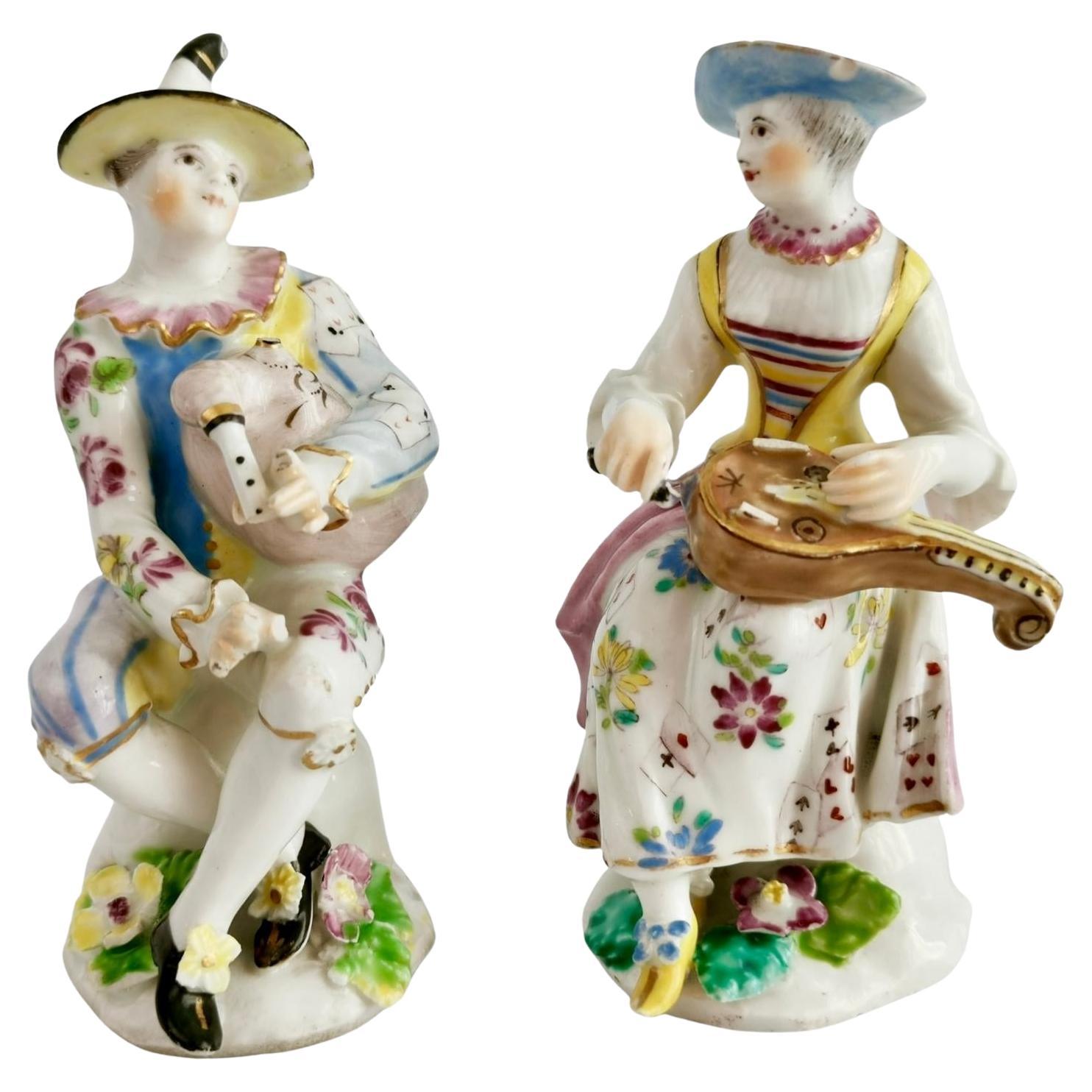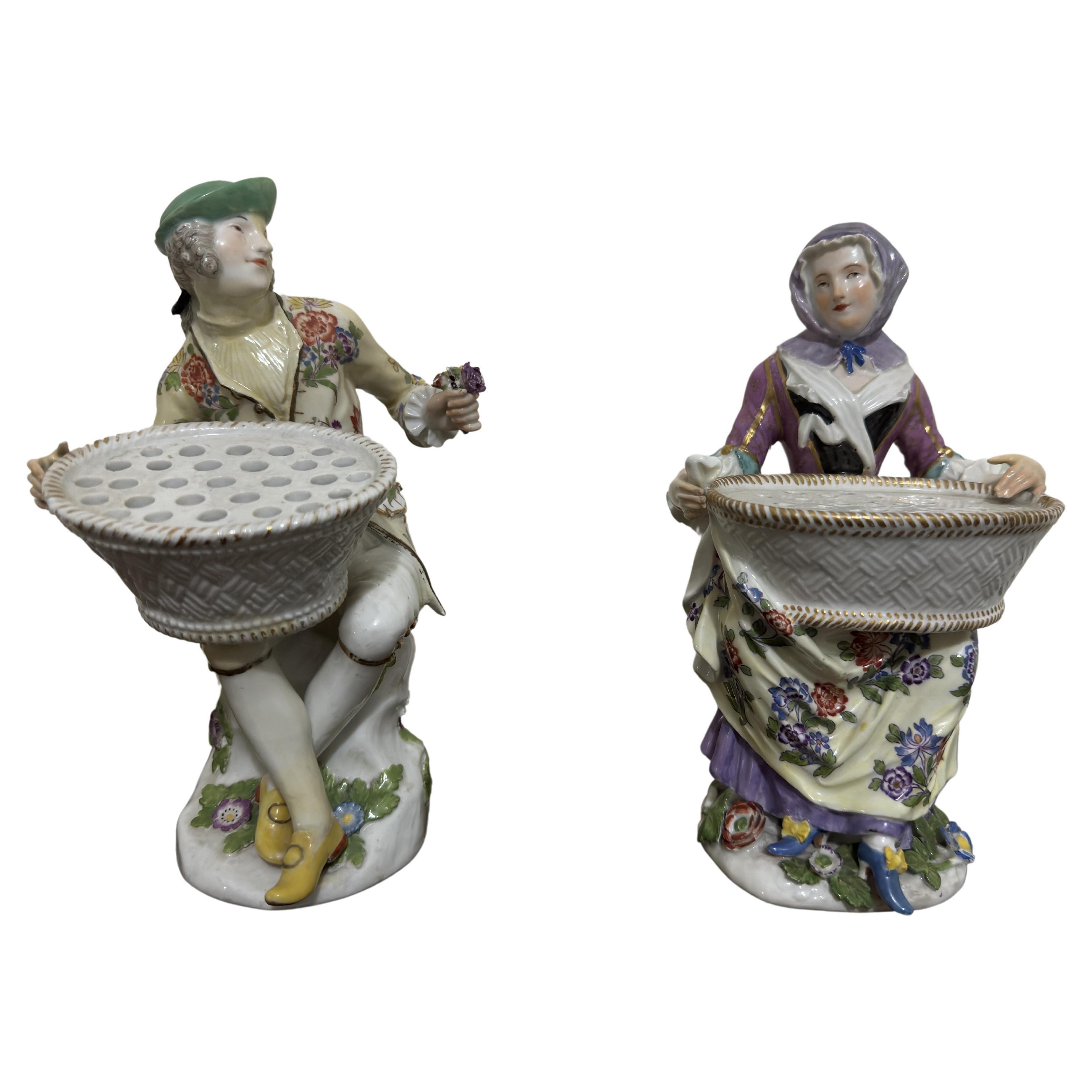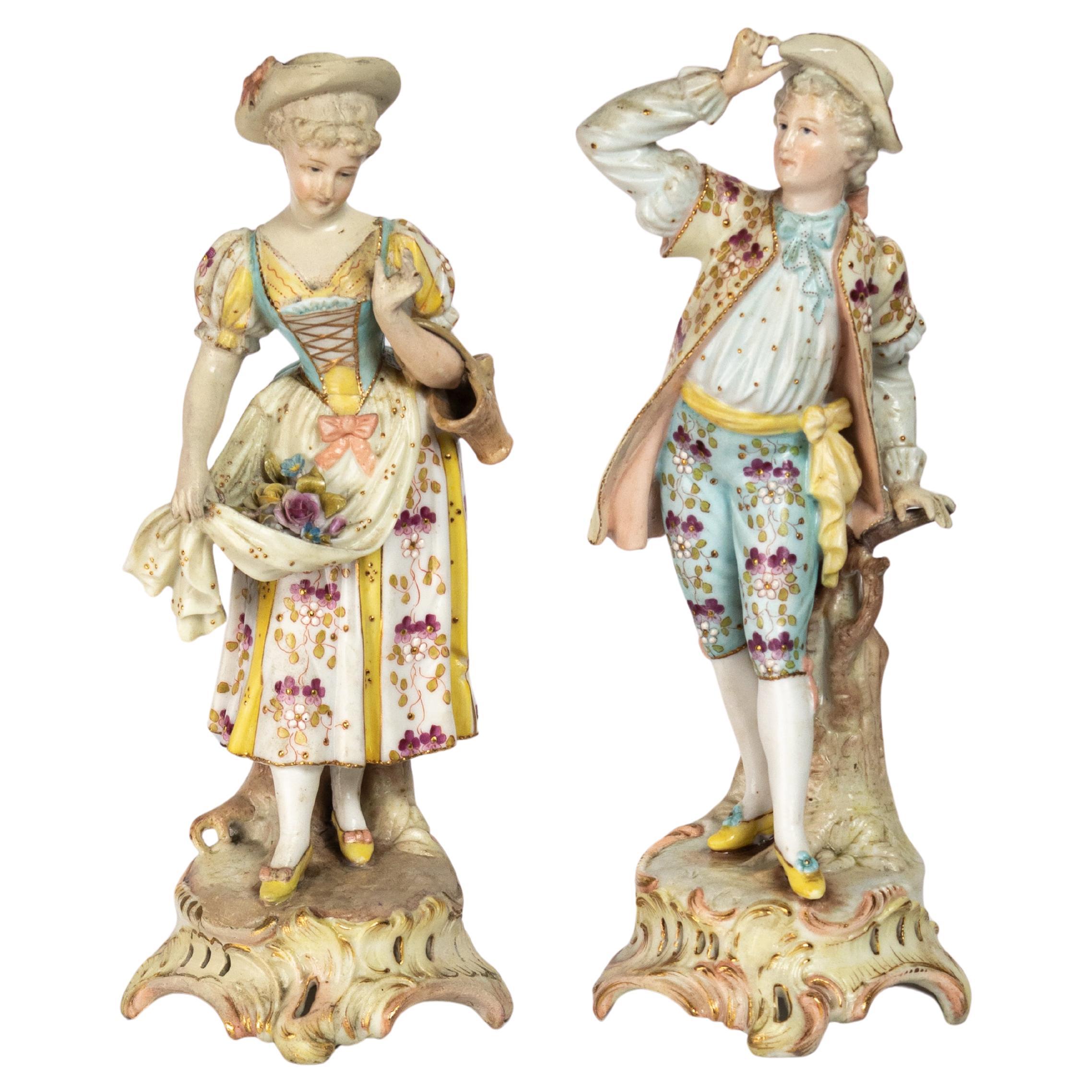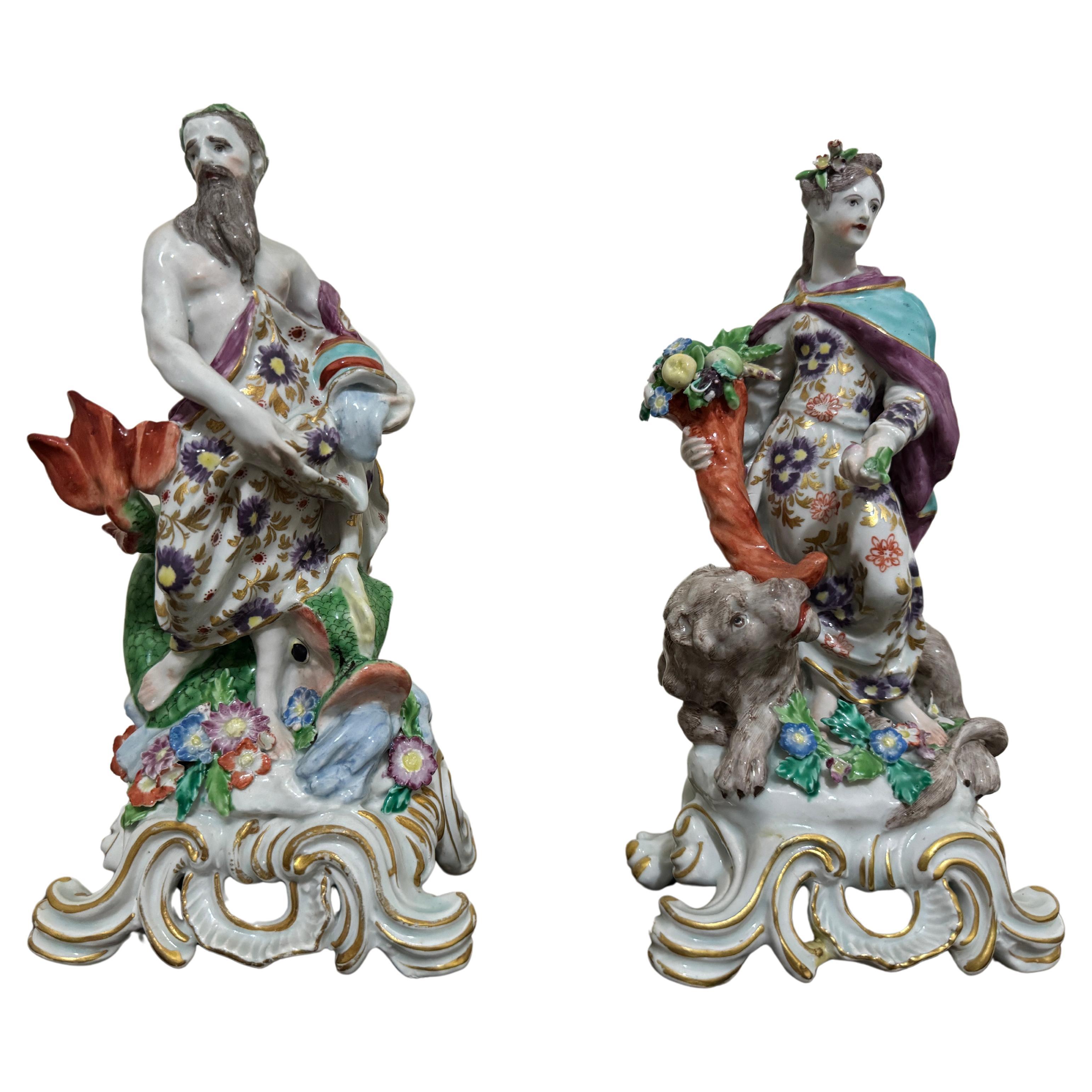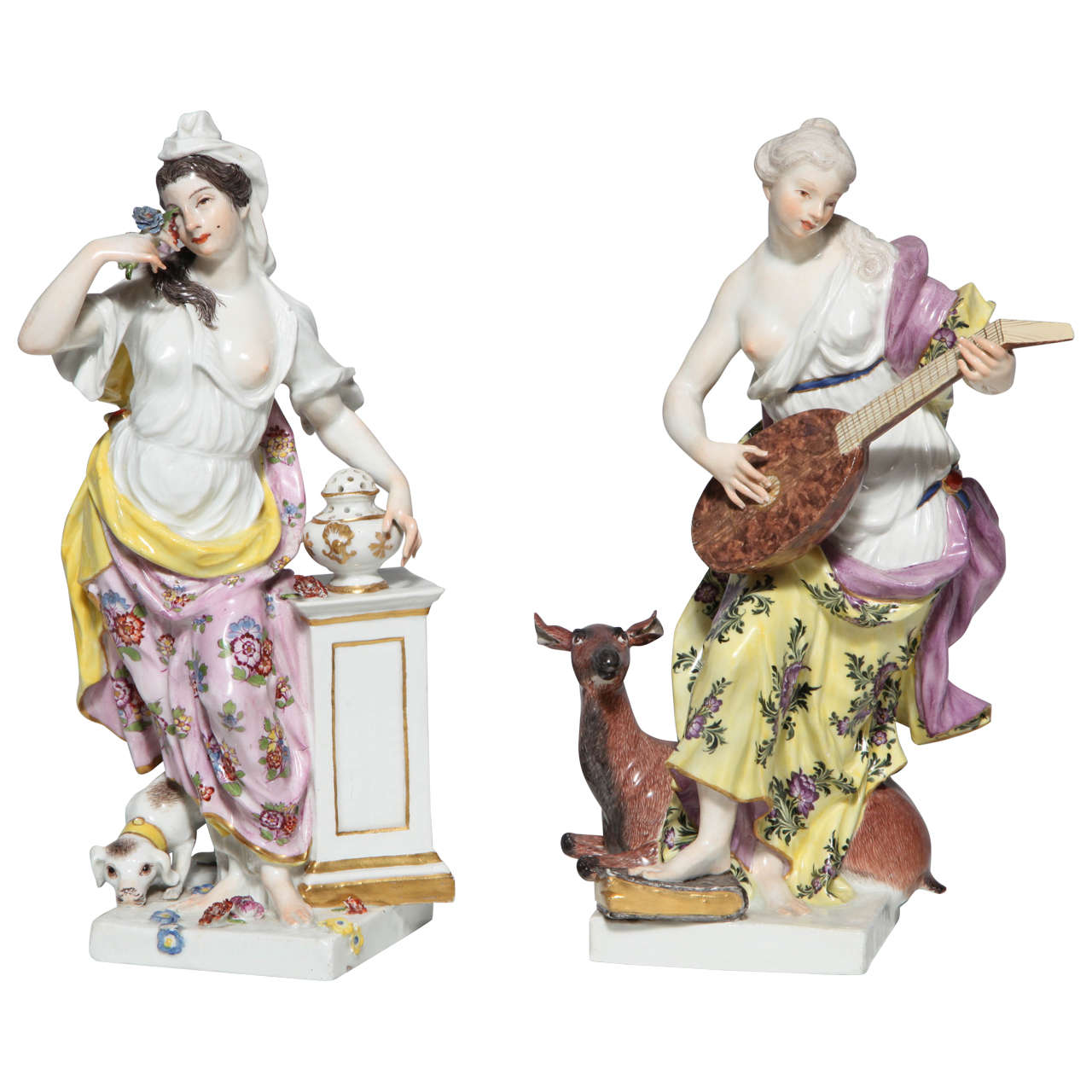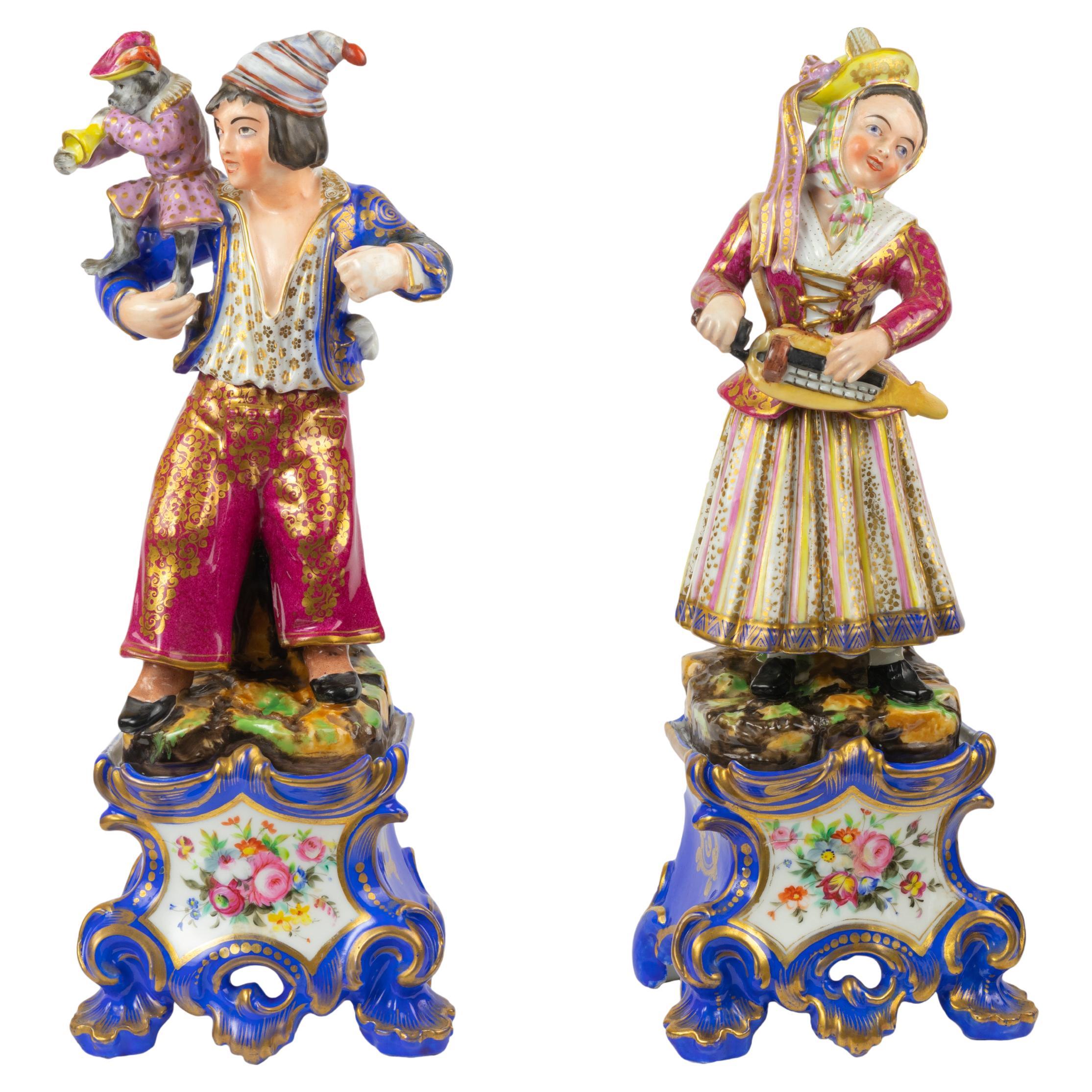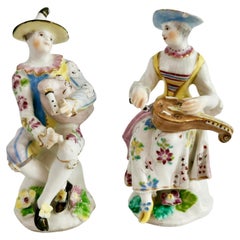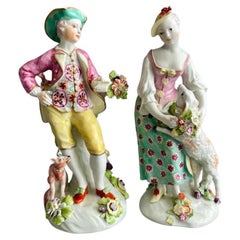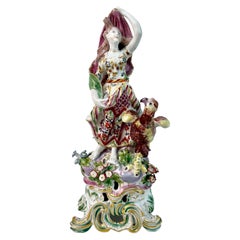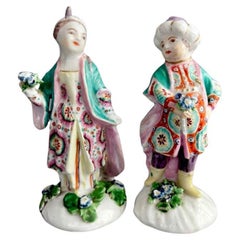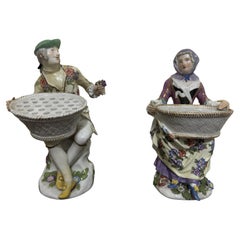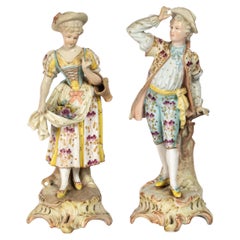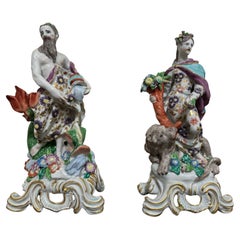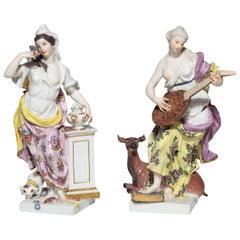Items Similar to Bow Pair of Porcelain Figures of Liberty & Matrimony, Rococo 1760-1764
Want more images or videos?
Request additional images or videos from the seller
1 of 21
Bow Pair of Porcelain Figures of Liberty & Matrimony, Rococo 1760-1764
$2,960per set
$3,700per set20% Off
£2,239.44per set
£2,799.30per set20% Off
€2,584.66per set
€3,230.83per set20% Off
CA$4,134.30per set
CA$5,167.87per set20% Off
A$4,596.55per set
A$5,745.68per set20% Off
CHF 2,406.02per set
CHF 3,007.52per set20% Off
MX$56,375.14per set
MX$70,468.92per set20% Off
NOK 30,634.66per set
NOK 38,293.33per set20% Off
SEK 28,922.75per set
SEK 36,153.44per set20% Off
DKK 19,287.62per set
DKK 24,109.52per set20% Off
Shipping
Retrieving quote...The 1stDibs Promise:
Authenticity Guarantee,
Money-Back Guarantee,
24-Hour Cancellation
About the Item
This is a fabulous pair of figures of Liberty and Matrimony made by the Bow Porcelain factory between 1760 and 1764. These figures were a popular pair portraying marriage.
The bow porcelain Factory was one of the first potteries in Britain to make soft paste porcelain, and most probably the very first to use bone ash, which later got perfected by Josiah Spode to what is now the universally used "bone china". Bow was the main competitor of the Chelsea Porcelain Factory, but where Chelsea made very fine slipcast porcelain, Bow made a different soft paste porcelain that tended to be softer and could be pressed into moulds. Bow served a larger public generally at lower prices. The factory was only in operation between 1743 and 1774, after which the tradition got incorporated into some of the later famous potteries such as Worcester and Derby.
These figures were used to adorn the dinner table when dessert was served; groups of figures served to express something about the host, the guests, or to direct the conversation. Liberty and Matrimony were of course very appropriate if there was any talk about arranging marriages at the dinner table - which is where such deals were often made.
We see Liberty, the male figure, standing next to a nest with eggs with another nest with three little chicks in his right hand, his left hand protectively held over the chicks. The female figure, Matrimony, is stood with a golden cage in her hands. Both figures are dressed in very dapper floral costumes and they are stood against a background of waist-high bocage with flowers placed on a Rococo scroll.
The figures are marked with the red anchor and dagger mark that was used in this period. An image of Matrimony can be found in Peter Bradshaw's book on Bow Porcelain Figures, page 151, plate 156 and the description of the pair, which have the number B114, on page 177.
Provenance: Works of Art from the Schroder Collection.
CONDITION REPORT The figures are in excellent antique condition with some invisible professional restorations and touch-ups; Matrimony's arms have been repaired as has a section of the front of the base; Liberty has chips off the birds' beaks and his fingers and some flaking of the green enamels. Some typical small losses of flowers, but generally looking fresh and authentic.
Antique British porcelain is never perfect. Kilns were fired on coal in the 1700s, and this meant that china from that period can have some firing specks from flying particles. British makers were also known for their experimentation, and sometimes this resulted in technically imperfect results. Due to the shrinkage in the kiln, items can have small firing lines or develop crazing over time, which should not be seen as damage but as an imperfection of the maker's recipes, probably unknown at the time of making. Items have often been used for many years and can have normal signs of wear, and gilt can have signs of slight disintegration even if never handled. I will reflect any damage, repairs, obvious stress marks, crazing or heavy wear in the item description but some minor scratches, nicks, stains and gilt disintegration can be normal for vintage items and need to be taken into account.
There is widespread confusion on the internet about the difference between chips and nicks, or hairlines and cracks. I will reflect any damage as truthfully as I can, i.e. a nick is a tiny bit of damage smaller than 1mm and a chip is something you can easily see with the eye; a glazing line is a break in the glazing only; hairline is extremely tight and/or superficial and not picked up by the finger; and a crack is obvious both to the eye and the finger. Etcetera - I try to be as accurate as I can and please feel free to ask questions or request more detailed pictures!
DIMENSIONS 22cm high (8.75").
- Creator:Bow Porcelain (Maker)
- Dimensions:Height: 8.75 in (22.23 cm)Width: 5 in (12.7 cm)Depth: 3.5 in (8.89 cm)
- Sold As:Set of 2
- Style:Rococo (Of the Period)
- Materials and Techniques:
- Place of Origin:
- Period:1760-1769
- Date of Manufacture:1760-1764
- Condition:Repaired: various invisible professional repairs, please see description. Wear consistent with age and use. Minor losses. In excellent antique condition with some restorations and typical small losses.
- Seller Location:London, GB
- Reference Number:Seller: A-BOW121stDibs: LU4805131373622
About the Seller
5.0
Gold Seller
Premium sellers maintaining a 4.3+ rating and 24-hour response times
Established in 2016
1stDibs seller since 2019
225 sales on 1stDibs
Typical response time: 2 hours
- ShippingRetrieving quote...Shipping from: London, United Kingdom
- Return Policy
Authenticity Guarantee
In the unlikely event there’s an issue with an item’s authenticity, contact us within 1 year for a full refund. DetailsMoney-Back Guarantee
If your item is not as described, is damaged in transit, or does not arrive, contact us within 7 days for a full refund. Details24-Hour Cancellation
You have a 24-hour grace period in which to reconsider your purchase, with no questions asked.Vetted Professional Sellers
Our world-class sellers must adhere to strict standards for service and quality, maintaining the integrity of our listings.Price-Match Guarantee
If you find that a seller listed the same item for a lower price elsewhere, we’ll match it.Trusted Global Delivery
Our best-in-class carrier network provides specialized shipping options worldwide, including custom delivery.More From This Seller
View AllBow Pair of Porcelain Figures, Arlecchino and Columbina, Rococo ca 1758
By Bow Porcelain
Located in London, GB
This is a wonderful pair of figures of Arlecchino and Columbina, made by the Bow Porcelain factory in about 1758. These figures formed part of a series of the Commedia dell'Arte, a very popular series of theatrical figures that served as decoration at the dinner table in the 18th Century.
The Bow Porcelain Factory was one of the first potteries in Britain to make soft paste porcelain, and most probably the very first to use bone ash, which later got perfected by Josiah Spode to what is now the universally used "bone china". Bow was the main competitor of the Chelsea Porcelain Factory, but where Chelsea made very fine slipcast porcelain, Bow made a different soft paste porcelain that tended to be softer and could be pressed into moulds. Bow served a larger public generally at lower prices. The factory was only in operation between 1743 and 1774, after which the tradition got incorporated into some of the later famous potteries such as Worcester and Derby.
These figures were used to adorn the dinner table when dessert was served; groups of figures served to express something about the host, the guests, or to direct the conversation. The Italian Commedia Dell'Arte, a comical form of masked theatre, was very popular in those days and Bow copied many figures of the German Meissen series that were brought out in the decades before.
This pair dates from about 1758, which was at the height of Bow's ability to make beautiful figurines often copied from Chelsea or Meissen. The pair is modelled after a Meissen pair by Kaendler. The porcelain is translucent with a beautiful milky glaze - Bow was probably the first pottery using bone in its porcelain recipe. Arlecchino (Harlequin) is playing the bagpipes, dressed in an odd costume of mismatched chintz and playing cards and wearing a funny black trumpet...
Category
Antique 1750s English Rococo Figurative Sculptures
Materials
Porcelain
$2,880 Sale Price / set
20% Off
Free Shipping
Derby Exceptional Pair of Porcelain Figures of the Garland Shepherds, ca 1765
By Derby
Located in London, GB
This is a beautiful pair of Derby figures called the "Garland Shepherds", made in about 1765. The pair is one of Derby's most famous figure pairs and it bears the catalogue number E2...
Category
Antique 1760s English Rococo Figurative Sculptures
Materials
Porcelain
$1,160 Sale Price / set
20% Off
Free Shipping
Bow Porcelain Figure of Juno with Eagle 'Jupiter', Rococo Ca 1765
By Bow Porcelain
Located in London, GB
This is a very rare and impressive large figure of Juno with an eagle, made by the Bow Porcelain factory in about 1765. This figure formed part of a series of the Four Elements, with...
Category
Antique 1760s English Rococo Figurative Sculptures
Materials
Porcelain
$2,400 Sale Price
20% Off
Free Shipping
Derby Pair of Porcelain Figures, "Boy and Girl in Turkish Costumes", ca 1770
By Derby
Located in London, GB
This is a rather rare pair of porcelain figures made by Derby around 1770. The pair was called the "Boy and Girl in Turkish Costumes", numbered 63 in Derby's factory list. They depic...
Category
Antique 1770s English Rococo Figurative Sculptures
Materials
Porcelain
$700 Sale Price / set
20% Off
Free Shipping
Bloor Derby Pair of Porcelain Figures, Stag and Doe, circa 1765-1820
By Derby, Bloor Derby
Located in London, GB
This is a very charming pair of porcelain figures of a stag and a doe, probably cast by Derby in about 1760 and decorated by Bloor Derby in 1820. The figures are a simple white porce...
Category
Antique 1760s English Rococo Figurative Sculptures
Materials
Porcelain
$668 Sale Price / set
20% Off
Free Shipping
Bow Porcelain Figure of Boy Putto on C-Scroll Base, Georgian circa 1760
By Bow Porcelain
Located in London, GB
This is a wonderful little figure of a boy or putto made by the Bow Porcelain factory in about 1760.
The Bow Porcelain Factory was one of the first potteries in Britain to make soft...
Category
Antique 1760s English Rococo Figurative Sculptures
Materials
Porcelain
$548 Sale Price
45% Off
Free Shipping
You May Also Like
Pair of 18th Century Meissen Porcelain Bouquetiere Figures
By Johann Joachim Kaendler, Meissen Porcelain
Located in Basildon, GB
A pair of Meissen bouquetiere figures Circa 1765, both with 'Christie's East' dealer stamps.
Modelled by J.J. Kändler holding oval two-handled baskets, the tops pierced for flowers, ...
Category
Antique 1760s German Rococo Figurative Sculptures
Materials
Porcelain
Meissen Porcelain Rococo Couple Figurines, Germany, 19th Century
Located in Lisbon, PT
A pair of 19th-century Meissen porcelain figurines in Rococo Revival style, depicting a romantic couple in floral costumes.
These finely detailed polychrome porcelain figures captur...
Category
Antique 19th Century German Rococo Revival Figurative Sculptures
Materials
Porcelain
$2,932 Sale Price
20% Off
Pair of Bow Porcelain Element Figures, "Water" and "Land" , circa 1765
By Bow Porcelain
Located in Basildon, GB
Pair of Bow Porcelain Element Figures, "Water" and "Land" , circa 1765, both brightly coloured, 'Water' depicted by Neptune and a large fish, and "Land" depicted by Ceres and a lion.
Category
Antique 1760s English Rococo Figurative Sculptures
Materials
Porcelain
Pair of 18th Century Meissen Porcelain Figurines of the Sense
Located in New York, NY
A fine pair of 18th century Meissen Porcelain allegorical figurines of smell and hearing from a set of the senses probably modeled by J....
Category
Antique 18th Century and Earlier German Rococo Sculptures
Materials
Porcelain
Pair Of Meissen Porcelain Couple Porcelain Figures, Germany, 20th Century
Located in Lisbon, PT
A Meissen polychrome porcelain pair of statues with a male with a monkey and young woman playing a hurdy-gurdy.
The woman wears a richly detailed traditional costume in magenta, gol...
Category
20th Century German Baroque Revival Figurative Sculptures
Materials
Porcelain
$2,506 Sale Price
24% Off
Large Pair of Porcelaine Figures of Lovers Singing
Located in Los Angeles, CA
A beautiful large pair of 19th century porcelain figures of lovers. Each figure is beautifuly decorated and hand painted. The gentelman is wearing a nice suite with vibrant colors th...
Category
Antique 1890s French Louis XVI Porcelain
Materials
Porcelain
$22,000 / set
More Ways To Browse
Rococo Scroll
Gilt Bow
Figures Porcelain Pair
Enamel Bow
Antique Rococo Porcelain
Green Painted Rococo
Rococo Dress
Porcelain Figural Group
Porcelain Figure Groups
Antique Soft Paste
Rococo Porcelain Sculptures
Chinese Female Figures
China Porcelain Plate Signed
China Bird Sculpture
Soft Paste Antique Porcelain
Bow China
Hand Painted Bone China
Antique Porcelain Egg
